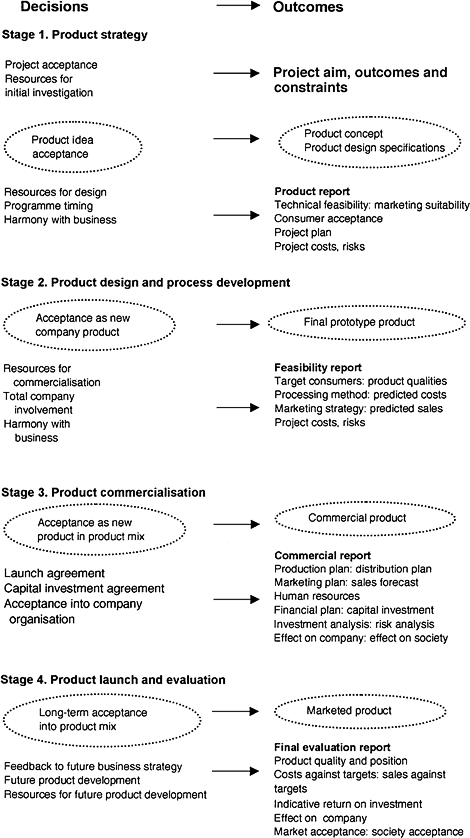FOOD
PRODUCT DEVELOPMENT
Mary Earle, Richard Earle and Allan Anderson |
| Loading
|
|
||||
|
|
Part
2, Chapter 3
The product development process 3.1.1 Defining the project The aim, outcomes and the constraints have been identified in the product development programme and presented to the product development team or manager for the project. But there is usually a need for further desk research by the team to determine the accuracy of the aim, outcomes and constraints and also to 'flesh them out' to give a more detailed project definition that can drive and control the project (Rosenau, 2000). This is also the time to select a suitable PD Process for the project and to set out an outline project plan.
There are four aspects of the initial research to define the project by developing more detailed aims: product ideas, consumers, technology and market as shown in Fig. 3.1.  Fig. 3.1 Defining the project: activities, outcomes and constraints. The research includes all aspects of the PD Process. At the same time the team is developing new product ideas, and relating them to the market possibility, to the technology possibility and to the product possibility. What are the products? Can they be made? Can they be sold? Who wants them? What do they need? These are the types of questions being discussed by the team and it is an important time for team interaction. This is only 'desk research' - using information in the company, outside records, published textbooks and papers, which are easily available. There is a maximum use of tacit knowledge within the group and within the company. Information technology has improved the storage and use of knowledge in product development, in particular the use of product models with a framework of raw materials, ingredients, packaging and production methods (Jonsdottir et al., 1998).
The second aim allows two different methods of processing. In other aims there may be two target markets, or two methods of marketing, as it is not clear at that time just which is the direction to go. Aims can be adjusted during the project but there must be agreed reasons for doing this. The outcomes for the different stages of the PD Process are developed from the aim, the company's PD Process for this type of product, and the decisions that the top management has indicated for different times in the project. In particular the decisions identified are used to determine the outcomes as shown in Fig. 3.2.  Fig. 3.2 Identifying the outcomes necessary for the decisions (After Earle amd Earle, 1999, by permission of Chadwick House Group Ltd).. There are both product and project decisions to be made, the product decisions and outcomes are ovals in Fig. 3.2. The general decisions are similar for many projects but there will also be specific decisions for each project. Therefore other outcomes will be needed. It is important to recognise the decisions that have to be made, and by whom, and to then select the knowledge needed in the outcomes to make these decisions. Outcomes are sometimes called objectives; they are the knowledge goals that have to be reached at the end of the different stages of the PD Process. In some projects, especially large projects, critical decisions may be made more often in the project; again these decisions have to be recognised and the required outcomes defined. It is important to select the outcomes by balancing the need for knowledge against the resources and time needed for the activities to give the outcomes. With the recent emphasis on faster but quality product development, more attention is being paid to selection of outcomes. The choice of outcomes and therefore of project activities depends on the risk of failure the company is prepared to take. Teams often seek extensive knowledge so that they are surer of the whole picture, but this can be expensive and take too long and even sometimes result in failure. There is history of some companies seeking too much information in the test markets, and being overtaken by other companies. Outcomes that are fundamental to the project and whose completion is necessary for the project are always included. Identifying possible outcomes at the beginning of the project and selecting the critical outcomes for the company and its environment, which are within the money and time the company is willing to provide, ensure a project that is efficient and effective. The constraints are any factors defining the area of the project. Some of these, such as financial resources and time for launching, will have been specified in the product development programme. At this time it is important to identify constraints on the product, processing and marketing, and also the constraints placed by the company and by the social and political environment. For example, the constraints from the food regulations and from society's attitudes to production, processing, food additives and safety need to be identified before product design starts. There are sometimes constraints caused by the availability of people and equipment. A checklist for studying constraints is shown in Table 3.1. Table 3.1 Project constraints: a checklist for product development projects
Source: From Earle and Earle, 1999, by permission of Chadwick House Group Ltd. The constraints need to be recognised but they must not be too tight as this could stifle the creativity in product design and process development. For example, specifying the protein level as exactly 20% for a perceived consumer need and not a requirement of the regulations could restrict the other product characteristics. But a protein range of 20-30% could satisfy the consumer but allow more freedom in design. It is important to criticise the constraints - are they all needed, are they too tight? Sometimes a company constraint may stifle the project, and it is important to revisit it with management to see if it can be changed. The aim(s), outcomes and constraints direct and control the project. They are used as factors in screening and evaluating the product ideas and product concepts, and then in evaluating the different prototype products. They are the basis for identifying the activities and choosing suitable techniques and for the project plan, which directs and controls the process. The outline project plan is based on the PD Process selected for the project and the outcomes identified. The PD Process varies according to the type of product - industrial, consumer and food service, and also whether the product is incremental or a major innovation. The activities are selected to give the outcomes previously identified. Choice of activities is not only determined by the knowledge needed in the related outcome, but also by the resources and time available. The description of the activity defines the outcome needed, the time frame to be met and the resources that can be used. The outline plan is set up so that everyone in the project can identify their place in the project and what they are aiming to achieve. They can start to select the techniques for their section of the project, particularly for the early stages.
|
|
 |